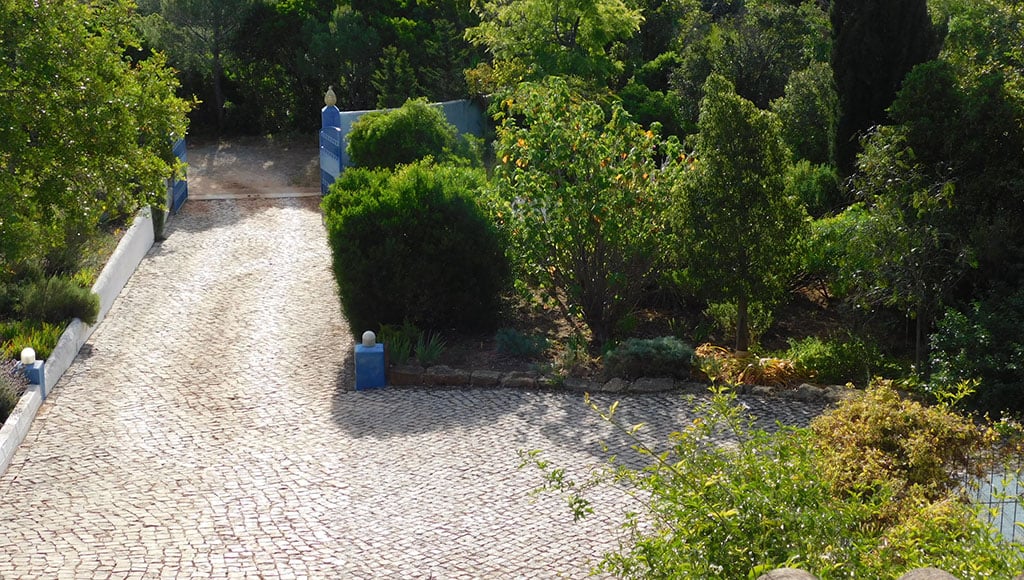Since buying our home in the eastern Algarve, it has been a steep learning curve, but now it is fun to have a garden which tolerates drought. It is also sensible and it’s easy – at least that’s the way it seems to me today, 20 years after we set out.
It feels good to garden in harmony with nature and in harmony with the mediterranean climate we chose for our home. A recent Open Garden Day allowed us to share our garden and show that minimum intervention can yield huge rewards.
Winters are mild and bring rain, around 300-600mm, here in the eastern Algarve. Quantities vary from year to year, but there seems to be less each year. Summers are long, hot and dry, but when we accepted these facts and planned our garden in accordance with them, most of the perceived difficulties that go with months-long drought disappeared.
Once I started to use plants which are native to Portugal and to the mediterranean climate, planted them in autumn and mulched well, let them soak up rain over winter and go dormant over summer, drought was no longer a problem. And our garden is healthy and thrives.
A dry garden is not bare soil with a few spiky cacti and agaves dotted about. On the contrary, it is evergreen and delights us with scent and flowers year-round.
Today I tend to forget the stony field we found; the assorted rocks and giant boulders are a delight. The derelict and abandoned areas of an old carob grove we found upon our arrival have, over the years, turned into our garden.
While we supervised clearing old growth, cut dead branches and tried to get wind-torn trees and shrubs back to health, I looked for the landscaping potential which lay hidden under much of the overgrown vegetation. Instead of total clearing, the existing plant world was put to good use as it promised a drought-tolerant garden for which its established roots gave a quick start.
The solid masses of the century-old carobs, with dense canopies of Mediterranean shrubs such as buckthorn, myrtle and lentisk, together with the silver-grey trunks of ancient olive trees, would, once a few paths were created, become a solid backbone to our natural garden. They brought shade which helps the establishment of a mediterranean garden and is a primary concern in the long, hot summer.
We were not tempted to introduce any areas of lawn but instead were delighted with the range of established trees. Trees cool the soil and prevent erosion; they also cool the house and cleaning allowed us to lift the crown and take advantage of their shade.
‘How to choose drought-tolerant plants’, ‘how to take care of them’, ‘where to find’ and ‘how to plant’ were recurring questions. Fortunately, we were aware of the work of Olivier Filippi at his nursery in south-west France, which focussed on arid and mediterranean zone plants. His books became our source of information and inspiration.
Plants will thrive when given the same conditions as in the wild (winter rain and summer drought for those from mediterranean climates).
Once a suitable site for each had been found according to its demands (sun or shade, northern or southern exposure, a cool root run or hot rock?), once we had planted carefully and mulched generously, the main work had been done.
Over the first and second summers, plants were established with additional watering deeply and infrequently. In late summer, an extra water ration or a protective palm frond brought quick relief.
Checking after moments of stress, such as after a dehydrating summer wind, slashing autumn rain or a devastating winter storm, became routine.
In comparison, this seems little if one considers the arduous fertilising, spraying and pulling around of hosepipes or servicing complicated irrigation systems which enslave many gardeners.
We retained as much vegetation as possible to keep humidity in the soil as a reservoir for a long dry summer, to preserve the earth from being washed away, to establish a thriving vegetation which clothes the thin soil, to improve the air we breathe and to create a refreshing breeze during hot summer days.
This also allowed the natural wildlife to prosper, and we were thrilled to find chameleons, lizards and snakes as well as a huge variety of birds and bats who wished to share the garden with us.
Mulching became standard. A gravel mulch shades roots and encourages plants to set seed and provide free plants. Sometimes doing nothing and letting nature show you the way is the best way to create your garden. We imitate nature which spreads a thick cover of decaying leaves and small twiggy material all over the ground. Heaps of pruning material were shredded and are used for mulching and making pathways.
Letting drought-tolerant plants rest over summer according to the natural life cycle (summer dormancy) makes for vigorous plants. They may discard older leaves or even a few branches but will come back with autumn rains. Summer watering usually does more harm than good and with many plants brings trouble: fungus invades humid dormant plants.
Observing the seasonal changes proved immensely useful. Evergreen hard leaves, the mediterranean sclerophyllous foliage, were a major factor in the green aspect of the garden. Soft, felty leaves or grey and silvery ones, finely indented, act as highlights.
Consideration of foliage came first and, if well chosen, guarantees drought tolerance and, at the same time, provides an unending choice of shape, colour and texture.
Making a cushion shape when pruning mimics forms found in nature, maintaining a congenial microclimate and echoes the natural plant growth of the surrounding hills.
With thanks to Dry Gardening Handbook by Olivier Filippi and Mediterranean Gardening, A Waterwise Approach (1000 drought-tolerant plants) by Heidi Gildemeister
By Rosie Peddle
|| features@algarveresident.com
289 791 869 | mgapsec@gmail.com
facebook.com/MedGardenersPortugal
www.mgaportugal.org




















